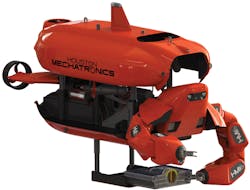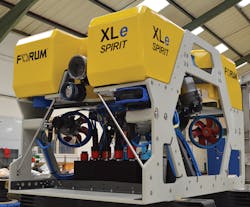Industry advances ROV and AUV technologies
New subsea robotics maximize uptime
Jessica Stump, Assistant Editor
Asthe offshoreoil and gas industry recovers, demand for remotely operated vehicles (ROV) autonomous underwater vehicles (AUV) increases.
Global utilization of the available ROV fleet fell to 32% in 2017, according to Westwood’s latestWorld ROV Operations Market Forecast. However, demand for both traditional oil and gas applications and new offshore support roles will assist a recovery in ROV demand between 2019 and 2023. The analyst expects that with upcoming attrition in the fleet and an improved demand outlook, utilization could return to 50% by 2023.
As operators continue to move into deeper waters, Westwood anticipates a notable uptake in AUV utilization for oil and gas operations. More offshore operators look set to deploy AUVs for life of field inspection programs, according to the analyst’sWorld AUV Market Forecast 2018-2022. The benefits of using AUVs for field inspection go beyond cost savings, said Westwood analyst Ian McDonald. They can increase operational safety, lessen the environmental impact of inspection operations, and reduce the number of personnel needed at sea.
The Aquanaut transforms from an AUV to an ROV.
(Courtesy Houston Mechatronics)
As operators look to sustain capital discipline, ROV and AUV manufacturers are responding with new systems that maximize uptime.
Houston Mechatronics has introduced Aquanaut, a multi-purpose subsea robot which employs a patented shape-shifting transformation from an AUV to an ROV. The vehicle, which removes the need for vessels and tethers, is said to enable both the efficient collection of data over long distances as well as manipulation of subsea objects at a lower cost than today’s technology. As an AUV, the Aquanaut can cover up to 200 km (108 nautical mi) in one mission and features vertical thrust control and an articulating bow. The company said it transforms into an ROV with four in-house designed linear actuators. The hull separates in one fluid motion, exposing two more control thrusters, the vehicle arms, and adding another degree of freedom to the vehicle head mechanism.
SEAMOR Marine Ltd. has unveiled Mako, a heavy payload ROV named after a shark. The Mako ROV can carry 14 kg (30 lb) as a standard build and is upgradeable to 22.5 kg (50 lb). This higher carrying capacity permits larger instrumentation (such as multi-beam imaging sonars) to be integrated. The new ROV can fly at 2 knots thanks to eight thrusters. Four vertical thrusters and four horizontal thrusters provide stability and maximized forward thrust. It also features a large accessory bay with an open, modular design. This design choice, the company said, provides ample space to mount and position accessories. The ROV has plenty of power to operate multiple accessories at once. A standard Mako measures 840 mm x 635 mm x 674 mm (33 in. x 25 in. x 27 in.) and weighs approximately 72 kg (160 lb).
Forum Energy Technologies has developed a range of electric ROVs. The XLe, designed and manufactured at the company’s Kirkbymoorside complex in northern England, is the first and smallest of the new range. However, it is sufficiently powerful to undertake subsea maintenance and repairs using its optional electric or hydraulic five-function manipulator arm.
According to the company, the vehicle’s self-regulating power feature compensates for tether losses, ensuring a constant and stable power delivery to the vehicle regardless of the length of the tether.
It employs the same Forum Integrated Control Engine (ICE++) that is featured in the company’s larger work-class and trencher vehicles. This is said to provide a range of auto-pilot and pilot assist modes when appropriate sensors are fitted.
A standard Mako ROV measures 33 in. x 25 in. x 27 in. and weighs about 160 lb.
(Courtesy SEAMOR Marine Ltd.)
Its latest electric ROV is the XLe Spirit. This is the first observation-class ROV to use Forum’s integrated control engine to bring greater functionality commonly only found in larger work-class vehicles. The ROV is said to incorporate several features to maximize its stability for use as a sensor platform, including regulated propulsion power, optimized thruster orientation and location, accurate thruster speed control and a wide range of auto-functions for positioning and flying.
Last year the ROV completed a 12-week test program at the company’s test tank in Kirkbymoorside, Yorkshire. Sea trials are expected to start in 1Q 2019.
A control electronics pod fitted to all XLe observation class vehicles, the company claims, enables superior connectivity and expansion capabilities. Ethernet interfacing allows for seamless integration with other industry sensors using common IP architecture and ease of remote data transfer.
Oceaneering has produced the E-ROV, a self-contained, battery-powered ROV system. Comprising an electric ROV, 4G connection buoy, and subsea cage, the system can operate for extended periods of time without being recovered to the surface, which reduces cost and risk.
Subsea 7 subsidiary i-Tech Services has extended its underwater inspection and maintenance service to include new mini ROVs for performing smaller scopes of subsea work. These are said to be quick to deploy and easily transported to the offshore location by helicopter or aircraft. The mini ROVs are said to offer high maneuverability and a power-to-weight ratio that allows them to carry small tools and manipulators that can be operated in strong currents. They can also be mobilized rapidly and manually from any platform, FPSO, barge or vessel of opportunity.
Saudi Aramco has inaugurated a torpedo-shaped AUV. The AUV is designed to perform surveys to identify seabed clearance and potential debris around offshore platforms. It can also conduct offshore pipeline inspections to determine subsea asset integrity and locate potential leaks. According to Aramco, the vehicle, which cost $2.5 million to construct, can handle duties formerly undertaken by a $50-million, large survey vessel.
Sea trials of the XLe Spirit eROV are expected to start in 1Q 2019. (Courtesy Forum Energy Technologies)
In addition, the AUV’s modular design allows for interchangeable modifications based on the mission’s needs. For example, the sidescan sonar/bathymetric module for geophysical operations can serve as a camera for subsea inspection projects, and as the environmental module for oil leak detection surveys.
An additional battery module can be added to the assembly, allowing the AUV to extend the length of its mission.
Aramco claims the AUV resembles a shrunken vessel, operable remotely from shore or from a boat controlling the vehicle through Wi-Fi when within reach of its connection limit. When at the required depth, the vehicle travels along its mission’s route by means of its Inertial Navigation System.
Research and development
Collaboration is playing a key role in helping the industry develop technologies and solutions to increase autonomy and remote residency of the subsea systems.
Shell has awarded Saipem a license to develop technology for FlatFish, a resident subsea autonomous vehicle designed to perform subsea asset inspections. This should be qualified for commercial application by 2020.
FlatFish is a Brazilian project previously developed over a four-year period by SENAI CIMATEC in partnership with DFKI, with funding from the ANP R&D program and EMBRAPII.
Sabertooth fitted with a Blue Logic inductive device is said to be the world’s first system capable of remote docking operations. (Courtesy Saab Seaeye)
Saipem plans to add capabilities for riser inspection, data harvesting from subsea sensors, contactless monitoring of cathodic protection systems, and a ‘flying-hanging garage’ for launch/recovery and subsea recharging/reprogramming of the FlatFish from offshore platforms. These enhancements will be supported by SENAI CIMATEC which, along with Saipem do Brasil, entered the development arrangement with Shell Brasil last December.
Ocean Power Technologies Inc. (OPT) and Saab Seaeye Ltd. have signed a non-exclusive agreement to pursue mutual opportunities through joint system solution development and marketing. The agreement anticipates a preliminary focus on AUV and ROV charging and communications systems.
OPT President and CEO George Kirby said: “We believe OPT’s PB3 PowerBuoy, coupled with Saab’s technologies, creates the premier unmanned system, providing remote charging capabilities for both autonomous and remotely operated vehicles. We believe the combined OPT and Saab system can revolutionize offshore subsea operations by allowing the vehicles to recharge on the seafloor and thus remain in the water longer and reduce the reliance on support from manned vessels. The unmanned system can increase the range of the vehicle, increase operational weather windows for the operators, while improving safety for the crew.”
In addition, Saab Seaeye said that its iCON-based hybrid AUV/ROV Sabertooth fitted with a Blue Logic charger is the world’s first system capable of remote docking operations. According to the company, the 3,000-m (9,842-ft) rated Sabertooth can be based at a remote location docking station ready to be launched on pre-programmed or man-controlled missions, including inspection, repair and maintenance, research tasks, and environmental monitoring. At the docking station, tooling packages are stored, batteries recharged, and data transferred via satellite or cable to shore.
Sonardyne International Ltd. has started a collaborative project to improve the autonomy for long-endurance AUVs. With partners L3 ASV and the National Oceanography Centre (NOC), the company will focus on longer-term navigational accuracy for AUVs in deepwater, while reducing power requirements and increasing autonomy in marine operations.
The Innovate UK-supported Precise Positioning for Persistent AUVs (P3AUV) project will involve trials using Sonardyne’s underwater positioning technology on the NOC’s Autosub Long Range (ALR) and L3 ASV’s C-Worker 7 autonomous surface vehicle (ASV). The project is due to run until late 2019.
P3AUV will focus on three key areas. One is to increase long-duration navigational accuracy by integrating low- and high-power inertial navigation system (INS) sensors. The second area is to improve positioning accuracy while underwater vehicles descend and ascend through the water column, through the integration of doppler velocity log current measurement capabilities and INS technologies with onboard data processing. The third area is to enable ASV deployment of seafloor positioning transponders. •




